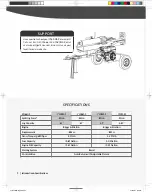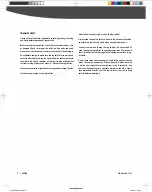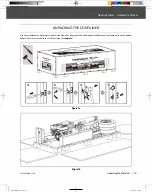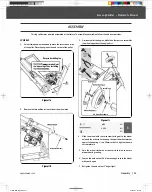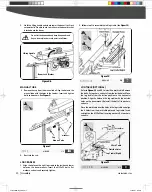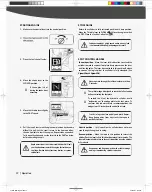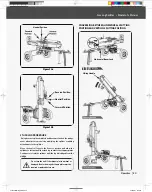
+
ENGINE SAFETY
This machine is equipped with an internal combustion engine.
Do not use on or near any unimproved, forest covered, or brush
covered land unless the exhaust system is equipped with a spark
arrester meeting applicable local, state, or federal laws.
In the state of California, a spark arrester is required by law.
Other states have similar laws. A spark arrester, if used, must be
maintained in effective working order by the operator.
Never start or run the engine inside a closed area. The exhaust
fumes are dangerous, containing carbon monoxide, an odorless
and deadly gas. Operate this unit only in a well-ventilated
outdoor area.
Do not tamper with the engine to run it at excessive speeds. The
maximum engine speed is preset by the manufacturer and is
within safety limits. See engine manual.
Keep a Class B fire extinguisher on hand when operating this log
splitter in dry areas as a precautionary measure.
FUEL SAFETY
Fuel is highly flammable, and its vapors can explode if ignited.
Take precautions when using to reduce the chance of serious
personal injury.
When refilling or draining the fuel tank, use an approved fuel
storage container while in a clean, well-ventilated outdoor area.
Do not smoke, or allow sparks, open flames, or other sources of
ignition near the area while adding fuel or operating the unit.
Never fill the fuel tank indoors.
Keep grounded conductive objects, such as tools, away from
exposed, live electrical parts and connections to avoid sparking or
arcing. These events could ignite fumes or vapors.
Always stop the engine and allow it to cool before filling the fuel
tank. Never remove the cap of the fuel tank or add fuel while the
engine is running or when the engine is hot. Do not operate the
machine with known leaks in the fuel system.
Loosen the fuel tank cap slowly to relieve any pressure in the tank.
Never overfill the fuel tank. Fill the tank to no more than 1/2"
below the bottom of the filler neck to provide space for expansion
as the heat of the engine can cause fuel to expand.
Replace all fuel tank and container caps securely and wipe up spilled
fuel. Never operate the unit without the fuel cap securely in place.
7
I Safety
Avoid creating a source of ignition for spilled fuel. If fuel is spilled,
do not attempt to start the engine but move the machine away
from the area of spillage and avoid creating any source of ignition
until fuel vapors have dissipated.
When fuel is spilled on yourself or your clothes, wash your skin
and change clothes immediately.
Store fuel in containers specifically designed and approved for
this purpose.
Store fuel in a cool, well-ventilated area, safely away from sparks,
open flames, or other sources of ignition.
Never store fuel or a machine with fuel in the tank inside a
building where fumes may reach a spark, open flame, or any other
source of ignition, such as a water heater, furnace, or clothes
dryer. Allow the engine to cool before storing in any enclosure.
HYDRAULIC SYSTEM SAFETY
The hydraulic system of the machine requires careful inspection
along with the mechanical parts. Be sure to replace frayed, kinked,
cracked, or otherwise damaged hydraulic hoses or hydraulic
components.
Hydraulic fluid can result in severe burns. Fluid in the hydraulic
system can penetrate skin and result in serious injury or death.
Be sure to stop the engine and relieve hydraulic pressure before
doing any work on hydraulic parts.
Keep body and hands away from pin holes or nozzles that expel
hydraulic fluid when under pressure. Use paper or cardboard, not
hands, to search for leaks.
Ensure all hydraulic fluid connections are tight and all hydraulic
hoses and lines are in good condition before applying pressure to
the system.
Do not remove the cap from the hydraulic tank or reservoir while
the machine is running. The tank could contain hot oil under
pressure, which could result in serious injury.
Do not adjust the pressure setting on the hydraulic pump or
valve.
If injured by escaping fluid, no matter how small the wound is, see
a doctor at once. A typical injection injury may be a small wound
that does not look serious. However, severe infection or reaction
can result if proper medical treatment is not administered
immediately by a doctor who is familiar with injection injuries.
YU2566PM02-1703
2020/3/27 14:08:51
+




